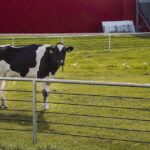In the rolling hills of British Columbia’s Fraser Valley, an ostrich farm now stands as a cautionary tale in Canada’s ongoing battle against highly pathogenic avian influenza. Federal inspectors have uncovered serious biosecurity violations at the operation, raising alarm about potential vulnerabilities in our agricultural defense systems against the highly contagious H5N1 virus.
Documents obtained through access to information requests reveal that the Canadian Food Inspection Agency (CFIA) identified multiple infractions at the ostrich farm following a disease outbreak earlier this year. Most concerning was evidence that infected birds had been moved between premises, creating dangerous pathways for viral transmission across the region.
“Movement of infected birds represents one of the most significant risk factors in disease spread,” explained Dr. Marion Delparte, a veterinary epidemiologist at the University of Guelph. “When protocols are breached, we’re looking at potential exponential spread that threatens not just individual farms but entire agricultural sectors.”
The violations occurred despite enhanced biosecurity measures implemented across the province after multiple avian influenza outbreaks devastated poultry operations throughout British Columbia since 2022. According to CO24 News records, more than 7.2 million birds have been culled in the province alone as authorities struggle to contain the virus.
Inspection reports highlighted alarming conditions at the facility, including inadequate quarantine procedures, insufficient personal protective equipment for workers, and improper disposal of potentially contaminated materials. These findings underscore the challenges facing regulators as they work to protect Canada’s $8.5 billion poultry industry.
The implications extend well beyond the farm’s boundaries. Economic analyses from CO24 Business show that each major avian influenza outbreak costs Canadian taxpayers millions in emergency response measures, compensation to producers, and lost export opportunities. The Canadian Poultry and Egg Processors Council estimates that trade restrictions triggered by such outbreaks can cost the industry upwards of $20 million per month.
British Columbia Agriculture Minister Pam Alexis expressed concern about the findings, noting that her ministry is reviewing options for strengthening provincial oversight of non-traditional poultry operations. “While chickens and turkeys remain our largest sectors, we cannot ignore the biosecurity requirements for specialty bird operations that can serve as viral reservoirs,” Alexis stated during a press conference Tuesday.
Public health officials maintain that the risk to human health remains low, though vigilance is warranted. The H5N1 strain has shown limited capacity for human infection globally, with most cases involving individuals with direct and prolonged contact with infected birds. However, World News reporting indicates that health authorities remain concerned about the virus’s ongoing evolution.
The ostrich farm case highlights a growing challenge in agricultural biosecurity: the diversification of livestock operations. Traditional regulatory frameworks designed primarily for conventional poultry may not adequately address the unique characteristics and management practices of specialty operations.
“Our regulatory systems were built around chicken, turkey, and egg production,” noted Dr. Thomas Wrigley, former CFIA regional director. “As agricultural practices diversify, we need adaptive approaches that maintain rigorous standards while acknowledging operational differences.”
Industry representatives argue that education, rather than punitive measures, should be the priority. “Many specialty producers lack the institutional knowledge and support systems available to conventional operators,” said Linda Hoffmann of the Small-Scale Farmers Association. “We need collaborative approaches that build capacity across all sectors.”
The incident occurs against the backdrop of increasing political tensions over agricultural regulations, with some producer groups advocating for more flexible approaches while public health experts emphasize the non-negotiable nature of disease control measures.
As federal and provincial authorities deliberate their response to these findings, the fundamental question remains: how do we balance agricultural innovation and diversity with the absolute necessity of protecting our food systems from devastating disease outbreaks? The answer may determine not just the future of specialty operations like ostrich farming, but the resilience of Canadian agriculture as a whole.

























